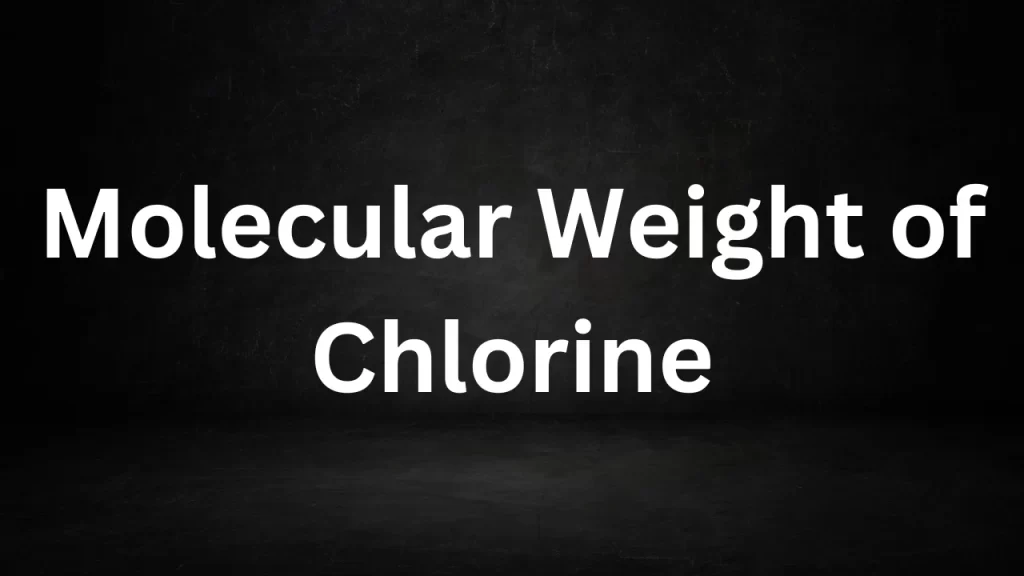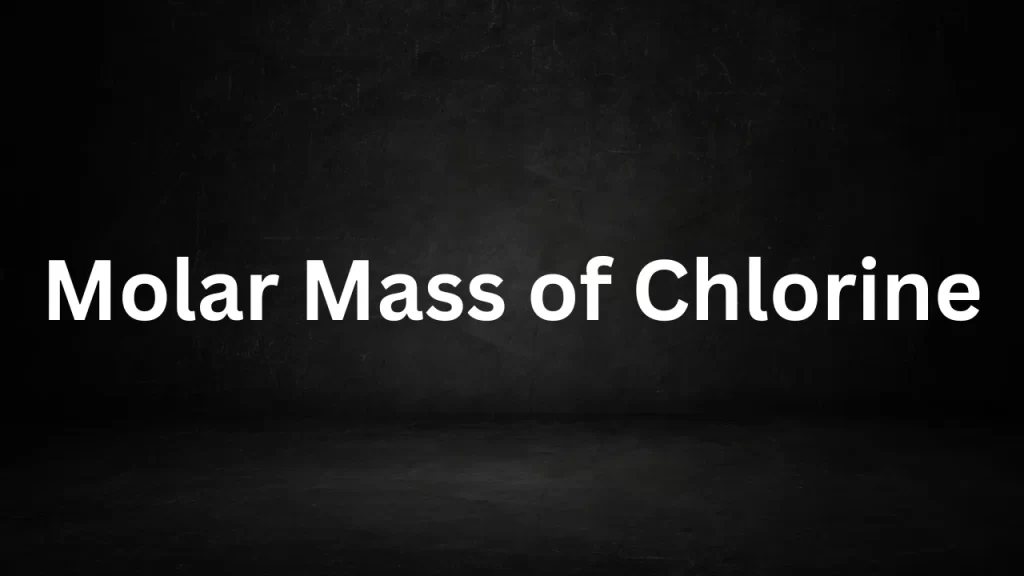Tag: atomic weight of sodium chloride
Molecular Weight of Chlorine
Molecular Weight of Chlorine: Chlorine is a highly reactive and essential element in the world of chemistry. It plays a crucial role in various chemical processes, from water purification to the production of household chemicals and pharmaceuticals.
One of the fundamental characteristics of any chemical substance is its molecular weight, a property that holds significant importance in understanding and working with chlorine. In this article, we will explore the concept of molecular weight and its relevance in the context of chlorine.

Molecular Weight of Chlorine
The Nature of Chlorine
Before delving into the molecular weight of chlorine, it is important to understand the nature of this element. Chlorine, denoted by the chemical symbol Cl, is a halogen found in group 17 (formerly group VIIA) of the periodic table. It exists primarily as a diatomic molecule, Cl2, composed of two chlorine atoms bonded together. This diatomic form is the most common and stable form of chlorine.
Importance of Molecular Weight
Molecular weight, also known as molar mass, is the mass of a molecule or compound expressed in atomic mass units (amu) or grams per mole (g/mol). It is a fundamental property in chemistry and plays a pivotal role in various aspects of chemical science and industry, including:
- Stoichiometry: Molecular weight is essential for determining the stoichiometry of chemical reactions, helping chemists balance equations and calculate reaction yields.
- Synthesis: Chemists use molecular weight to measure and combine reactants accurately when synthesizing compounds or formulating solutions.
- Analytical Chemistry: Molecular weight is crucial in identifying and quantifying compounds through techniques like mass spectrometry.
- Physical Properties: Mol weight influences a substance’s physical properties, such as melting point, boiling point, density, and solubility.
Calculating the Mol Weight of Chlorine
To calculate the mol weight of chlorine (Cl2), you need to consider the atomic mass of a single chlorine atom. The atomic mass of chlorine is approximately 35.45 atomic mass units (amu).
Now, let’s calculate the mol weight of chlorine (Cl2):
Mol Weight of Chlorine (Cl2) = (2 × Atomic Mass of Chlorine) Molecular Weight of Chlorine (Cl2) = (2 × 35.45 amu) Molecular Weight of Chlorine (Cl2) = 70.90 amu
The mol weight of chlorine (Cl2) is approximately 70.90 amu.
Implications of Chlorine’s Molecular Weight
The molecular weight of chlorine, approximately 70.90 amu, holds several implications in the field of chemistry and industry:
- Quantitative Analysis: In analytical chemistry, chlorine’s molecular weight is crucial for accurately determining its concentration in samples, such as in water quality testing.
- Chemical Reactions: Chlorine’s mol weight is essential for stoichiometric calculations in chemical reactions involving chlorine gas, ensuring precise measurements and predictions.
- Safety: Understanding the mol weight of chlorine is important in handling and storage to prevent accidents since chlorine gas is toxic and can be hazardous when mishandled.
- Industrial Applications: Chlorine’s mol weight is a key parameter in industries using chlorine for various processes, including the production of chemicals, plastics, and pharmaceuticals.
Conclusion
- The molecular weight of chlorine, approximately 70.90 amu for the diatomic molecule Cl2, is a fundamental property that plays a pivotal role in chemistry and industry. It is crucial for stoichiometric calculations, precise measurements, and the understanding of chlorine’s physical and chemical properties. As an element of great significance in various applications, chlorine’s molecular weight continues to be a critical parameter for chemists and professionals working with this versatile and essential element.
Read More
- Molecular Weight Of Benzene
- Lumen Meaning In Biology
- Molecular Weight Of Sucrose
- Molecular Mass Of Carbon
- Molar Mass Of Phosphorus
Frequently Asked Questions (FAQs) Molecular Weight of Chlorine
Q1: What is molecular weight, and why is it important in chemistry?
A1: Mol weight, also known as molar mass, is the mass of a molecule or compound expressed in atomic mass units (amu) or grams per mole (g/mol). It is important in chemistry for various reasons. It including stoichiometry, determining reactant and product quantities in chemical reactions, and understanding physical properties of substances.
Q2: What is the chemical symbol for chlorine, and what is its common form?
A2: The chemical symbol for chlorine is Cl. Its common form is the diatomic molecule Cl2, where two chlorine atoms are bonded together.
Q3: How is the mol weight of chlorine (Cl2) calculated?
A3: To calculate the mol weight of chlorine (Cl2), you sum the atomic mass of a single chlorine atom, which is approximately 35.45 atomic mass units (amu). Then multiply by 2 (since there are two chlorine atoms in Cl2).
Q4: What is the mol weight of chlorine (Cl2)?
A4: The mol weight of chlorine (Cl2) is approximately 70.90 amu (atomic mass units).
Q5: Why is the mol weight of chlorine important in water treatment?
A5: Chlorine is commonly used in water treatment to disinfect and purify drinking water. Its mol weight is important because it helps in accurately measuring the amount of chlorine needed to effectively treat water. It also ensure water safety for consumption.
Molar Mass of Chlorine
Molar Mass of Chlorine: The molar mass of an element is a fundamental concept in chemistry, crucial for various calculations in the field. In this article, we will delve into the molar mass of chlorine (Cl), one of the essential elements on the periodic table.

Molar Mass of Chlorine
Introduction to Chlorine
Chlorine is a chemical element with the symbol Cl and atomic number 17. It is a halogen, belonging to Group 17 (formerly Group VIIA) of the periodic table. Chlorine is a diatomic molecule in its natural form, existing as Cl2 gas. It is known for its distinctive pungent odor and is commonly used in a variety of industrial and household applications, such as water disinfection, bleach production, and as a component in various chemicals.
Atomic Structure of Chlorine
To understand the molar mass of chlorine, we must first examine its atomic structure. A chlorine atom consists of 17 electrons, arranged in three energy levels or electron shells. The electron configuration of chlorine is 2-8-7, indicating that it has two electrons in the first shell, eight electrons in the second shell, and seven electrons in the third shell. The outermost shell, with its seven electrons, is referred to as the valence shell.
Chlorine’s atomic number, 17, tells us it has 17 protons in its nucleus, giving it a positive charge. It also has 17 electrons to balance this charge, making it electrically neutral. In addition to the protons and electrons, the nucleus of a chlorine atom contains 18 neutrons, which are electrically neutral particles with a mass similar to that of protons.
Molar Mass of Chlorine
The molar mass of an element is defined as the mass of one mole of atoms of that element, measured in grams per mole (g/mol). It is a crucial quantity for chemical calculations because it allows chemists to relate the mass of a substance to the number of atoms or molecules it contains. To calculate the molar mass of chlorine, we need to consider the contributions of its isotopes.
Chlorine has two stable isotopes: chlorine-35 (17 protons and 18 neutrons) and chlorine-37 (17 protons and 20 neutrons). These isotopes occur in nature in different proportions. Approximately 75.77% of naturally occurring chlorine is chlorine-35, while the remaining 24.23% is chlorine-37.
To calculate the molar mass of chlorine, we take a weighted average of the masses of these isotopes, using their natural abundance as the weighting factor:
Molar Mass of Chlorine (Cl) = (Fractional Abundance of Cl-35 × Mass of Cl-35) + (Fractional Abundance of Cl-37 × Mass of Cl-37)
Molar Mass of Chlorine (Cl) = (0.7577 × 35.453 g/mol) + (0.2423 × 37.967 g/mol)
Molar Mass of Chlorine (Cl) ≈ 26.94 g/mol
So, the molar mass of chlorine is approximately 26.94 grams per mole.
Importance of Molar Mass
The molar mass of chlorine is a fundamental value used in various chemical calculations. It is essential in determining the amount of chlorine needed for specific reactions, stoichiometry calculations, and the formulation of chemical equations. Additionally, molar mass plays a critical role in determining the concentration of chlorine in solutions and mixtures, such as in water treatment processes.
Understanding the molar mass of elements is a fundamental step in mastering chemistry, as it forms the basis for various chemical calculations and laboratory experiments. Chlorine, with its molar mass of approximately 26.94 g/mol, is no exception, and its properties and behavior in chemical reactions are deeply influenced by this important value.
Read More
- Electrical Energy And Power
- Dynamics Of Circular Motion
- Molecular Weight Of Acetic Acid
- Difference Between Torque And Power
- Difference Between Emission And Absorption Spectra
Frequently Asked Questions (FAQs) Molar Mass of Chlorine
Q1: What is the mol mass of chlorine?
A1: The mol mass of chlorine (Cl) is approximately 26.94 grams per mole (g/mol).
Q2: Why is the mol mass of chlorine important in chemistry?
A2: The mol mass of chlorine is crucial in chemistry because it allows chemists to relate the mass of chlorine atoms or molecules to the number of atoms or molecules present. It plays a fundamental role in stoichiometry, chemical calculations, and the formulation of chemical equations.
Q3: How is the mol mass of chlorine calculated?
A3: The mol mass of chlorine is calculated by taking a weighted average of the masses of its isotopes, chlorine-35 and chlorine-37, using their natural abundances as weighting factors. Approximately 75.77% of naturally occurring chlorine is chlorine-35, and about 24.23% is chlorine-37. The calculation is as follows:
mol Mass of Chlorine (Cl) = (Fractional Abundance of Cl-35 × Mass of Cl-35) + (Fractional Abundance of Cl-37 × Mass of Cl-37)
Q4: What is the significance of chlorine’s atomic number and electron configuration?
A4: Chlorine’s atomic number, 17, indicates the number of protons in its nucleus, which defines its chemical identity. Its electron configuration, 2-8-7, reveals the arrangement of its electrons in energy levels or electron shells, helping us understand its chemical behavior and reactivity.
Q5: Are there any practical applications of chlorine’s mol mass?
A5: Yes, there are practical applications of chlorine’s molar mass. It is used in various industries and applications, including water treatment, where the concentration of chlorine in solutions must be precisely controlled for effective disinfection. Additionally, the mol mass of chlorine is used in chemical manufacturing processes and in calculating the quantities of chlorine needed for specific reactions.